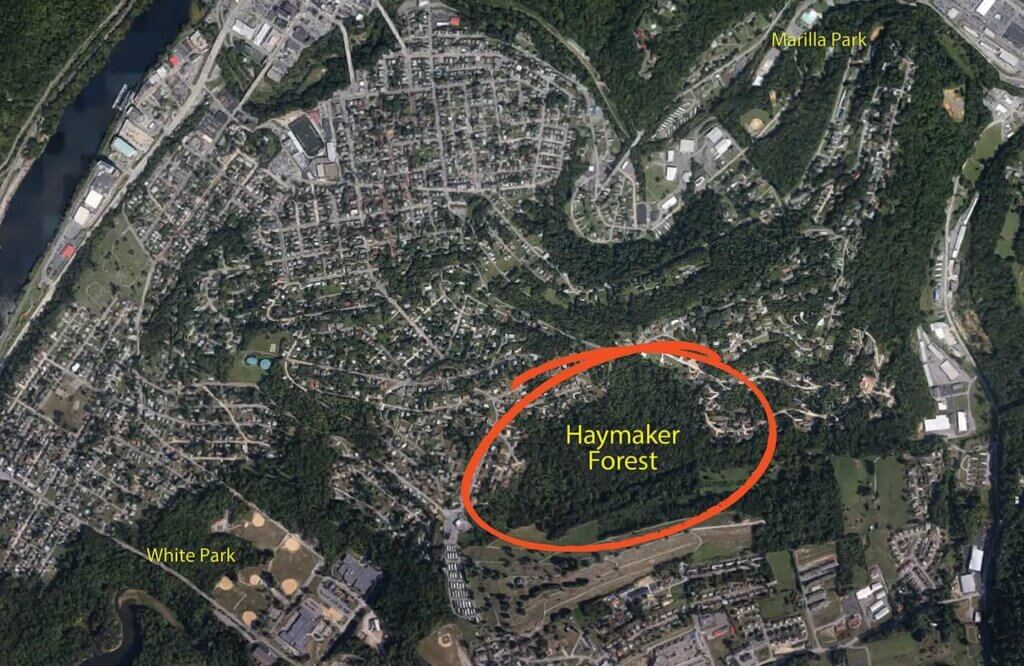What value does Morgantown place on preserving greenspace?
➼ Morgantown’s planning process for greenspace preservation became a hot-button topic in June with the proposal to buy the 40-acre Haymaker Forest. Situated between Marilla and White parks, the plot is bordered to the south by the East Oak Grove Cemetery and Dorsey Avenue and to the north by Buckhannon Avenue. Small streams flow across the property into Aarons Creek, which eventually enters Deckers Creek. Lush trees cover most of the land.
Walking and biking trails cut across the otherwise pristine property that has quietly been under the city’s eye since 2013. The 10-year Comprehensive Plan released in that year categorized the Haymaker property as a “reserve” area, meaning it “may be subject to development and should be considered for preservation.”
Most of the land is just outside city limits. But with the fate of the Haymaker in the hands of property owners Theresa Angotti, Donald Lazzelle, and James Prete, the city suddenly, this spring, felt pressure to act. Residents had a different idea.
Controversy from the Start
In October 2015, the South Hills, South Park, and Southpoint neighborhoods presented a position paper to city and county leaders opposing a “massive new development project” in the Haymaker Forest, adjacent to the neighborhoods. The project moved forward, with blueprints, water plans, and developers’ maps submitted to the Morgantown Planning Commission and the Morgantown Utility Board. The development was halted by the Planning Commission in August 2016 when the safety of the proposed entrance to the development was questioned.
But when heavy machinery was spotted on the property in May 2018, the city began making moves to acquire and preserve it. And when the asking price became public, controversy blossomed.
The issue was not whether adding greenspace to the city’s existing network of parks and trails is a good idea or not, but rather, the price tag. The property was pitched at $5.2 million, double the appraisal that eventually came in at $2.5 million.
Public dialog in the newspaper and on talk radio grew heated. It boiled over at the June 19 city council meeting. Nearly 50 people spoke during the public hearing on the proposed purchase, most of them strongly opposed to it. After Morgantown Fire Chief Mark Caravasos launched into an extensive list of deferred maintenance and purchases, a recurring theme emerged: Morgantown has a lot of competing priorities and limited resources to address them.
Existing parks in need of repair and other potential patches of greenspace that hadn’t been considered were just a couple of the concerns raised by those opposing the purchase. In response to a proposed tax increase or bond funding for the purchase, many suggested alternatives like grant funding. Those in support defended the value of adding to Morgantown’s greenspace over the specifics of this acquisition. “I think we need to pay it forward,” said JoNell Strough. “Anyone who’s visited a state park or national park or city park has had the benefit of someone who acted.”
But the overarching sentiment of the evening was this thought from Beth Ryan: “I am not opposed to greenspace. I am very much opposed to this purchase.”
Council voted to postpone it for further negotiation.
Looking Ahead
Morgantown’s outdoor recreation space falls just a little short of the 1 acre per 100 people recommended by the American Planning Association. That’s accounting for a population of about 60,000, including students, and the city’s 340 acres and WVU’s 185 acres of greenspace in town. And while there’s no shortage of greenspace outside town, a trip to Coopers Rock State Forest or Snake Hill Wildlife Management Area can be a lot to fit into a weeknight, at around 30 minutes one way.
And the city’s population continues to grow.
Given that, the need this sudden situation revealed for an ongoing mechanism to evaluate available properties is well timed. City Manager Paul Brake would like to see that need filled by a land reuse and preservation agency, first proposed to council on July 26.
The new agency would consider the highest use of available properties, whether for affordable housing, commercial purposes, public space, or conservation, and would carry out acquisition and management as appropriate. And one major task of the agency, Brake says, would be to work toward a greenbelt or greenway—a designated section of undeveloped, wild, or agricultural land just outside the urban area meant to benefit wildlife and preserve the land. It could also serve as an alternative transportation corridor for trails that bypass congested areas, adding to the alternative transportation spaces we already have in the Mon River and Deckers Creek rail-trails.
Given the strong support expressed at the June 19 meeting for a considered approach to greenspace preservation, Brake is hopeful that the land reuse and preservation agency will have the public’s backing. “If we can get the agency up and running and show the good they can do, we can change minds.”
written by Carmen Bowes
